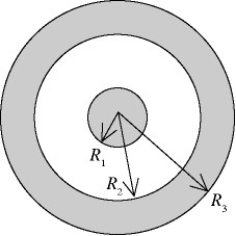Two concentric spheres are shown in the figure.The inner sphere is a solid nonconductor and carries a charge of +5.00 µC uniformly distributed over its outer surface.The outer sphere is a conducting shell that carries a net charge of -8.00 µC.No other charges are present.The radii shown in the figure have the values R1 = 10.0 cm,R2 = 20.0 cm,and R3 = 30.0 cm.(k = 1/4πε0 = 8.99 × 109 N ∙ m2/C2)
(a)Find the total excess charge on the inner and outer surfaces of the conducting sphere.
(b)Find the magnitude and direction of the electric field at the following distances r from the center of the inner sphere: (i)r = 9.5 cm,(ii)r = 15.0 cm,(iii)r = 27.0 cm,(iv)r = 35.0 cm. 
Definitions:
Involuntary Reflexes
Automatic, unconscious body responses to certain stimuli that do not involve the brain's direct command.
Conditioning
A process of behavior modification by which a subject comes to associate a desired behavior with a previously unrelated stimulus.
Handedness
The preference most people show for using one hand over the other for tasks; typically described as being right-handed, left-handed, or ambidextrous.
Hereditary
Pertaining to the passing of traits from parents to their offspring through genes.
Q4: Suppose that a steel bridge,1000 m long,was
Q18: A heavy stone of mass m is
Q21: A -7.0-μC point charge has a positively
Q22: A tiny object carrying a charge of
Q26: As shown in the figure,an insulated wire
Q30: An electron is released from rest at
Q31: It is a well-known fact that water
Q49: A 4.0-mF capacitor is discharged through a
Q50: A circular loop of wire lies in
Q52: Heat is added to a pure substance